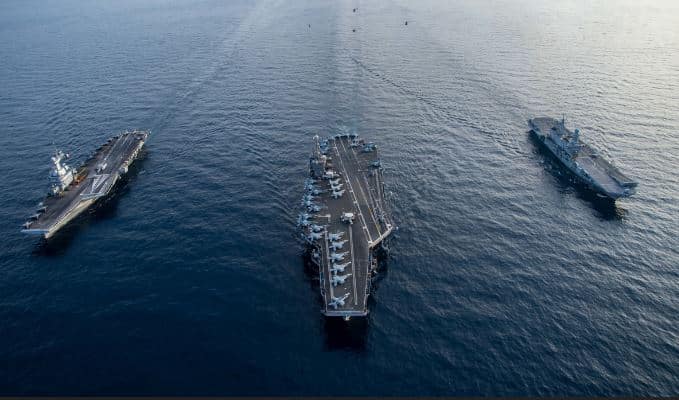
Russia has decided to use the force necessary in Ukraine. The Russians have begun to destroy the Ukrainian lines of communications — the power grid, bridges, roads and railroads — without which Ukraine’s forces can’t be resupplied. Once the destruction of the lines of communication is completed, Russia’s army, particularly its extensive artillery, will present Ukrainian forces with the unpleasant reality that they are vastly outgunned and outnumbered.
How far west Russia chooses to advance is an open question but it must be assumed that in addition to the four oblasts already claimed — Luhansk, Donetsk, Zaporizhzhya and Kherson — they’d want at least Mykolayiv and Odesa. With those two additional oblasts Russia would have absorbed most of the territory referred to as Novorossiya (New Russia) and deprive what’s left of Ukraine access to the Black Sea. In addition, Odesa shares a border with Transnistria, a breakaway Moldovan state which has hosted a small (two battalions) Russian Army presence since 1995.
Once the Russian advance begins, NATO can either accept Russia’s victory or engage the Russians with NATO forces. While a compelling case can be made that this conflict should have been seen as a local matter with an inevitable outcome, there’s little to suggest NATO’s leadership is capable of drawing that conclusion.
Unfortunately, Russia is a formidable adversary. Russia leads the world in air defense systems. NATO air forces would be engaging Russia’s S-400 air defense system. The S-400 is generally regarded as the world’s best widely fielded system. NATO member Turkey, for example, purchased the export version of the S-400 over NATO objections and in preference to the US Patriot system. The Russian S-500, an improvement of the S-400, has only recently entered production and is currently deployed at critical sites in Russia.
Russia has an estimated five year lead over the US in hypersonic missiles. The US has no defense against hypersonic missiles, which travel at hypersonic speed and can vary their flight paths. While the US is still conducting hypersonic tests, Russia has fielded four different hypersonic missiles within their existing missile system families — Kinzhal, Kalibr, Iskander and Tsirkon — so far. They also have a hypersonic glide vehicle, the Avengard.
Among the highest value military targets anywhere is a US Navy aircraft carrier. Should NATO enter a war with Russia, the US Navy’s carrier task force in the Ionian Sea is an obvious Russian target. How can it successfully defend itself against Russia’s simultaneous and probably massive hypersonic and conventional missile attack?
The inability of a carrier task force, the linchpin of the US Navy’s surface fleet, to survive a missile attack would have enormous implications and an immediate real-world impact.
Should the Russians sink a carrier task force, Taiwan would, for example, have to rethink any illusions it has about the US coming to its aid in a conflict with China and become far more amenable to a soft conquest similar to the Chinese takeover of Hong Kong.
The US Navy’s core missions are Power Projection, Sea Control, Strategic Deterrence and Strategic Sea Lift. While the US Navy has excellent submarines which play an important role, the Navy’s core missions require a powerful surface fleet, currently built around aircraft carriers.
Building capable and survivable modern warships is a complex and time consuming process. It’s what makes the Navy the most inelastic and capital intensive service. When it comes to defending the United States against a capable adversary, the Navy is also America’s most essential service.
The US currently has in excess of 850 bases around the world. Boots on the ground give the US influence of a sort the Navy can’t match and are essential to those who see the US as the world’s policeman. Inexcusably, the cost of these bases and the extended (and counterproductive) efforts in Afghanistan, Iraq, Syria and now Ukraine, have come at the expense of the Navy and America’s defense.
While the US Navy is, by far, the world’s largest Navy in tonnage, China’s Navy has more ships and an ambitious naval construction program. China’s fleet is expected to continue its rapid growth while the US Navy is expected to shrink. Congress has begun to address the US Navy’s limited ship yard capacity but continues to limit the Navy’s budget in preference to the other services.
Funding and ship yard capacity aren’t the only serious problems which need to be addressed. The Buy American Act of 1933, the Trade Agreements Act of 1979 and the Berry Amendment — which has existed since the beginning of WWII and became permanent law in 1993 — are the principal military construction domestic content laws. While this is a complex legal subject constrained by a number of factors, waivers of critical components which permit the use of foreign components in domestic military construction are overdue for review, as America’s deindustrialization has greatly expanded the need for waivers. The case for additional waivers is also furthered by permitting consideration of the cost of components. All of this combines to leave military construction vulnerable in a future conflict. Congress should recognize the necessity of quickly moving to 100% US components and understand that initial costs incurred in domestic production are a one time cost. Military construction requirements can be an important catalyst for US manufacturing which, in a conflict, will prove essential.
For the last twenty years, the Russians and the Chinese have sought to strengthen their armed forces while America’s leadership has, on a bipartisan basis, been obsessed with the Middle East. As a result, a persuasive argument suggests the US is no longer unbeatable. Let’s hope it isn’t too late to change course.
McConnell is a Colonel, US Army Reserves, Retired and graduate of the US Army War College. Formerly a Member of the New Hampshire House of Representatives.

